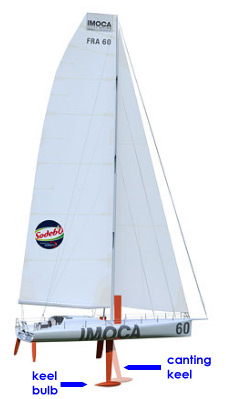Question asked by Neal:
Two skippers talked about losing their keel. What is a keel and how does it work? And why is a broken keel so bad for a boat? asked by Jan M.
Answer:

Answered by Dr. Ioannis Miaoulis, President & Director, Museum of Science, Boston
Ever noticed sailboats have fins sticking down below them? One — sometimes two — at the back (or stern) are rudders for steering. Generally there’s also one about halfway back. If that fin is fixed, it’s called a keel. If it can go up and down through a slot in the hull, it’s called a daggerboard, and if it pivots like the blade on a jack knife, it’s called a centerboard.
Keels perform two functions. First, they keep the boat from sliding sideways through the water, counteracting the push sideways from the wind (which the centerboard and daggerboard also do). Second, if a keel weighs a lot (and they usually do), they provide mass down low which helps balance the boat to keep it upright. Some ocean-going racing boats (like the boats in the Vendée Globe) have a “canting keel” which can be tilted a bit from side to side providing extra balancing “oomph” for better performance. Some boats with canting keels also have a daggerboard on each side. On racing boats, the keel’s balancing effect can also be enhanced against the force of the wind by filling the water ballast tank on the upwind side and emptying the tank on the downwind side.
If you lose your keel, your boat will capsize or at the very least will be unable to carry much sail, since without that weight down low, the boat is much less stable. In the unlikely case that the boat can still float upright without its keel, you might be able to use the water ballast to provide some balancing, but it would be tricky. You’ll also have lost the second function of the keel — to keep the boat from sliding sideways. If the boat had a canting keel and daggerboards, you might have fin area left in the daggerboards, providing modest resistance to sliding sideways. But even if the boat could balance upright without its keel and you had or could Jerry-rig daggerboards, the boat’s ability to carry sail and not slide sideways would likely be severely limited. You couldn’t do much more than sail downwind in the hope of finding a safe haven. More likely, you’ll be thankful if the boat has watertight compartments and resists sinking until you’re rescued.
At the Museum of Science, Boston you can trace how keels, hulls, sails, and rigging have evolved over thousands of years in an exhibit of small ship models of ancient Egyptian, Phoenician, and Viking ships as well as Columbus’s Santa Maria, the Mayflower, a clipper ship, schooner, whaler, and yacht.

